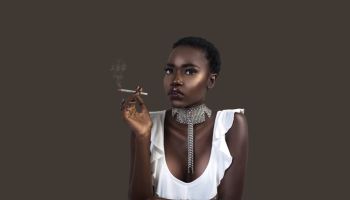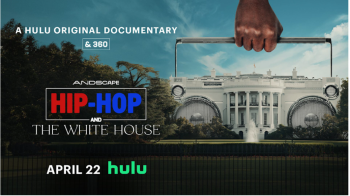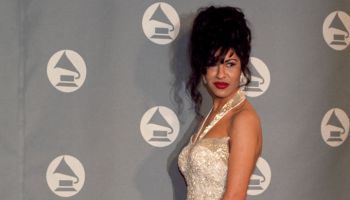If you’ve kept a close eye on the natural hair world, it may have proven difficult not to hear about the Heat Free Hair Movement. But contrary to how it sounds, there isn’t an army of women behind it, just the talents of 20-something-year-old hair stylist Ngozi Opara.
As a hair stylist, Ngozi, who owns a natural hair studio in Washington, D.C. called NZO Hair Studios, didn’t start the movement for her own needs, but as a portal to provide natural hair alternatives to her clients. The result was a movement that encourages women to embrace protective styling in the form of weaves and extensions because of the benefits it provides.
Her line of hair is the very first of its kind, and while there are sure to be a plethora of copycats in the near future, her ingenious innovation will help women embrace their Kinks, Kurls and Koils with care.
We had the opportunity to chat with Ngozi, who bared the wrath of the Polar Vortex to joining us in our NYC offices to talk about her personal hair journey, the factory process of emulating African-American hair, and more. Check it all out in the interview below and get familiar.
GlobalGrind: What was your personal natural hair journey like?
Ngozi Opara: I have been natural now for a little over 10 years. I went natural by accident, in my family a perm was the way to growing up. So, I always had a perm and one year I just stopped taking care of it and my roots were growing out and I had my permed ends. Eventually what happened was, there’s that point where your natural hair reaches your relaxed ends and your hair just snaps right there.
One day I was just like, let me cut this off and see how it goes. So I cut it off and had a nice little bush and I did a year of weaves and in that year my hair grew like nine inches, it was huge, it was the biggest I’ve ever seen my hair. I was like ‘I’m sold! I’m going to do this, like I’m going to do this natural thing.’ At the time I was already working in hair, I was already in hair school; I was working in African braiding galleries, so I knew about hair, but I didn’t necessarily know so much about natural hair. That’s when I decided to look into working for Carol’s Daughter, so I worked for them for a little bit, learned a bunch of stuff about natural hair, then from there it was like, ‘oh! I’m going to stick to this full-time.’
Would you say when you started 10 years ago, there was a void in the market for natural hair care products? What would you use?
There was nothing! There was Carol’s Daughter. That was it. There’s so much out there now, which is great, but could also be confusing for a lot of new naturals. Some of the stuff that is out now I wish could have been back then, but to me I feel like if you use one whole family of products, you can’t go wrong. So back then, I was just using all of Carol’s Daughters products and my hair was just fine.
How did the idea for Heat Free Hair come about?
I’ve been a hairstylist for a while and my main focus has always been protective styling through weaves. Just because of my experience with my growth. And I noticed that a lot of my clients were natural, but half way natural, meaning they had the natural hair in the back and the relaxed portion in the front of their hair where they leave it out, or the heat damaged portion in the front of their hair to get it to blend with Brazilian or different types of hair texture. So after a while, I just started feeling like I was being counterproductive where I was growing client’s hair super long in the back and giving them all sorts of breakage by having them leave their hair out.
I knew there had to be a way for these women to go heat and chemical free, but still use weaves as a protective style of choice, so I said, ‘Hmmm go heat free that’s pretty cool, let me start a heat free hair movement’ and that’s where it came from.
Who was the first person that you were like ‘Alright, you’re going to be my guinea pig, you’re going to try this out?’ Was it one of your friends?
It was actually a friend of mine, Alex Elle. She’s also a natural hair blogger, which actually kind of helped Heat Free Hair to blossom over night. I’ve known her for 14 years, she was like, ‘I want something that looks like my hair texture,’ so I was like, ‘oh well, guess what I’m starting, this little movement and you can be my first client and we’ll go from there.’ So she wore it and people were like (gasp) ‘we want what Alex has’ and it worked.
Tell us about the actual product itself, making the hair work, the science behind it.
It started from a few months of testing; it’s definitely a foreign concept to a lot of factory makers making hair to look like African-American hair, so it was something that I had to first find samples of. My sister and two clients of mine were willing to let me cut some of their hair out to find textures that blended specifically with theirs. The next step after that became finding a factory that actually wanted to work towards creating that texture and that was really hard. I don’t know if you’ve seen the movie Good Hair at all, do you remember when Chris Rock brought the kinky textured hair to the store and they’re like, ‘No! We don’t sell that!’ That’s how a lot of factories were; like ‘we don’t even understand what that is and we’re not going to do it.’
I was able to find some factories that were willing to work with me with just months of sampling and testing. Pretty much in terms of how to create the textures we put the hair through three to four days of chemical-free process where it’s rolled, the kinkier it is, the smaller it’s rolled and it’s pretty much how you would if you have ever gotten braids and you had to roll them and dip them in hot water, take it out and let it curl. It’s similar to that, but it’s a stronger steam. It doesn’t harm the actual hair cuticle, but it just gets it to create different textures.
Have you had any experience with women who were afraid to embrace the natural lifestyle because of “Natural Nazis?”
The natural hair community, it’s a great community in a sense; it gives women who want to embrace their natural textures a community platform to interact with. But beyond that, not everyone who’s natural is the same. You know, not everyone’s a deep sister girl into all sorts of stuff and I think I definitely had a lot of clients who felt like, ‘If I go natural I have to be this way, I have to be deep, I have to be into organic stuff, I have to be vegan, I have to be this whole entire lifestyle.’ I think it’s been easy for my clients not to be that way, because I’m not that way.
For me it’s like, ‘I am who I am.’ I wear what I want, I eat what I want and even though I’m natural under this heat free hair, I still do me. I’m not THAT girl. I definitely got a lot of that when it came to the weaves, when Heat Free Hair first launched, there were the naturals who were so accepting of it and that were like, ‘Wow thank God, we finally have our texture’ and there were those like, ‘You can’t wear weave and be natural, like how could you do this? This is horrible.’ Then some of them still get it anyway and later on they’re like, ‘I love it!’ So I’ve had a lot of that. But I think for me it’s just that when you know who you are and what you stand for, all of that just doesn’t really excite you.
Where do you seek inspiration for new styles?
Honestly, I see some of the most creative people on the streets, sometimes I’m like, ‘How did you do that?’ You know, just walking around. Also, nowadays there are all sorts of websites. There’s Curl Box that has an amazing Instagram, that all of these different natural hairstyles; it’s great. There are a lot of different people who have their own little personal Pinterests on Instagram where they’re reposting a bunch of pictures and I’m like, ‘Oh that’s cool, let me try that on my next client.’
Be sure to check out video tutorials from Ngozi and more from Heat Free Hair here.















